Tag archives: art and science
New constellations, happy birthday Kristian Birkeland, ‘There once was a chemist from Bath…’
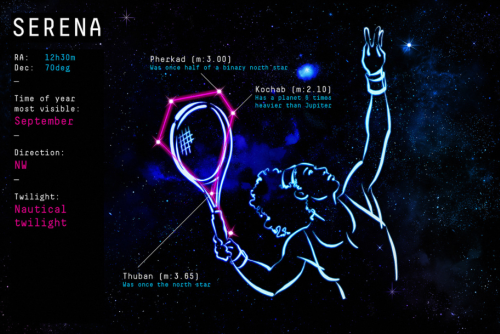
Reach for the stars: constellation Serena (Courtesy: University of Birmingham)
By Hamish Johnston
Astronomers at the University of Birmingham have dreamt-up a set of modern constellations in a bid to inspire young people to take an interest in the cosmos. The constellations are related to eight admirable people including J K Rowling, Usain Bolt, Malala Yousafzai, David Attenborough, Mo Farah and Michael Bond. But my favourite is the tennis racquet shaped constellation Serena, named after Serena Williams.
View all posts by this author | View this author's profile
Physics World’s shortlist for Book of the Year 2017
By Tushna Commissariat
The first week of December can only mean one thing – it’s time to reveal the shortlist for the Physics World book of the year. We’ve based our choice on the 54 books we’ve reviewed over the last 12 months in Physics World, picking our favourite 10 using the same three criteria that have been in place since we launched our book of the year award in 2009. These are that the books must be well written, novel and scientifically interesting to physicists.
Following on from a tumultuous 2016, this year has seen much political strife and human-rights crises, along with the rise of the unexpected demon of “fake news”. Unsurprisingly, the books we reviewed in Physics World this year reflected a lot of these global issues, which means that, along with the usual mix of popular-physics titles, the 2017 shortlist has a few books that at first sight might not seem to have direct links to physics. However, we feel these titles are nevertheless important and relevant to physicists (and of course scientists in general).
Given the number of strong and interesting books on our shortlist, it’s going to be hard to pick a single winner. That, however, is what we shall endeavour to do, via the Physics World podcast next week, when we’ll announce the award-winning book and discuss some of our other favourites on the shortlist. Let us know which ones you have read and are your favourite, and which you may be adding to your Christmas list.
View all posts by this author | View this author's profile
Great wrong theories, new spin on golf, physics photo competition
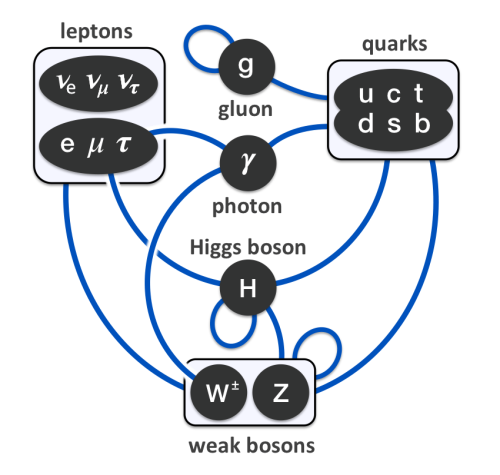
The Standard Model: wrong, but wonderfully wrong (Courtesy: Eric Drexler)
By Hamish Johnston
What is the greatest wrong theory in physics? Physicist Chad Orzel asks that question in his latest blog for Forbes and by wrong he does not mean incorrect, but rather incomplete. He makes the argument for the Standard Model, which he says has been wrong for a very long time – but continues to be phenomenally successful.
View all posts by this author | View this author's profile
Quantum quartet is on the cards
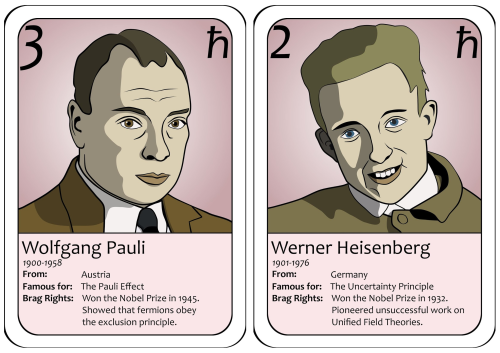
Quantum pair: Wolfgang Pauli and Werner Heisenberg (Courtesy: Sabine Hossenfelder)
By Hamish Johnston
Theoretical physicist and blogger Sabine Hossenfelder has created a lovely set of cards featuring pioneering quantum physicists. You can see my two favourites above.
Resembling football or baseball cards, they each feature a portrait plus a fact or two about the physicist – including a salacious aspect of Erwin Schrödinger’s personal life. You will have go to Hossenfelder’s blog to learn more about that – and see the rest of the cards, including a feline “Bra-ket” as the joker of the deck.
View all posts by this author | View this author's profile
A punt on Planck, physicist puts Frankenstein to music, would Brian Cox cope on Mars?
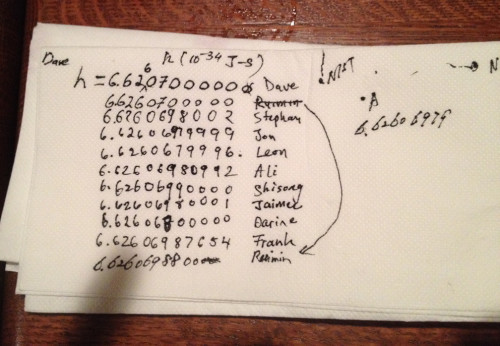
Fancy a flutter? The NIST napkin. (Courtesy: NIST)
By Hamish Johnston
A paper napkin with a load of numbers scrawled on top has been an unusual source of excitement for physicists at the US National Institute of Standards and Technology (NIST) in Gaithersburg, Maryland. One evening in December 2013, a group of them had gathered at a local watering hole to celebrate the success of NIST’s latest watt balance – NIST-3 – that had just determined Planck’s constant to a new accuracy. While enjoying “happy hour”, NIST researcher Dave Newell pulled out a napkin and the 10 researchers began to write down their predictions for the final value of Planck’s constant that NIST would submit to the International Bureau of Weights and Measures in Paris to help redefine the kilogram. The researchers then sealed the napkin in a plastic bottle and buried it inside a cavity within the foundation of NIST-3’s successor NIST-4, which was then being constructed.
View all posts by this author | View this author's profile
Ravens at LIGO, stained-glass physics, fake space pics
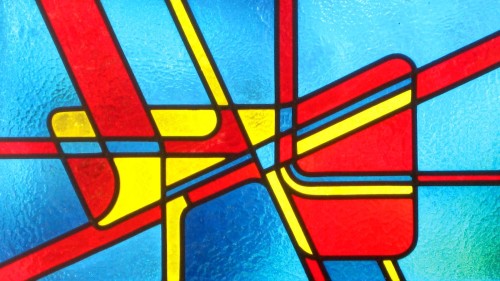
Grand designs: Los Alamos physicist Hubert van Hecke combines his hobby of stained-glass windows with physics. (Courtesy: Hubert van Hecke)
By Michael Banks and Sarah Tesh
Researchers working on the Laser Interferometer Gravitational-Wave Observatory might be answering some of the biggest questions in astrophysics, but last week they had a rather more down-to-Earth problem to solve. When spurious glitches were picked up by the detector characterization group at the LIGO detector based in Hanford, Washington, they went on an investigation to find the culprit. The team suspected that ravens were to blame as they had been seen causing mischief on tubes that vent nitrogen gas. These pipes are connected to the vacuum enclosure and any vibration could change the optical path length of light that is scattered from the test mass and reflected back. Upon closer inspection, LIGO researchers found peck marks that were “consistent with the size of a raven’s beak”. Not content with just watching the birds at play, the team even performed “simulated pecking” to see how this affected the machine’s performance. With the culprit now identified, you will be pleased to hear that the lines are set to be insulated to fend off the birds. “I guess we can’t blame [the ravens] for desiring ice on a hot desert afternoon,” writes Robert Schofield in a LIGO logbook post.
View all posts by this author | View this author's profile
Science, scepticism and fear at the theatre
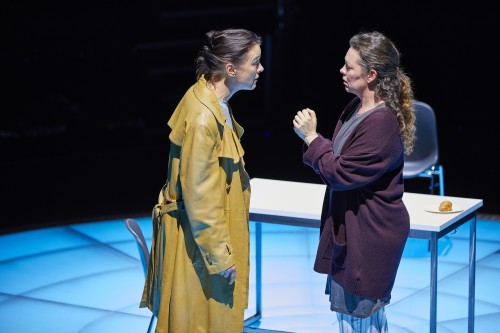
Sceptical siblings: Olivia Williams (left) and Olivia Colman in Mosquitoes by Lucy Kirkwood. (Courtesy: National Theatre/Brinkhoff & Mogenburg)
By Tushna Commissariat
Working at Physics World for the last six years has taken me to some pretty cool labs – everywhere from CERN to the Laser Interferometer Gravitational-wave Observatory (LIGO). My job has allowed me to meet some quite famous people too…at least in the world of physics, that is. But getting to spend a morning at the National Theatre in London watching Olivia Colman and Olivia Williams rehearse for a play is not usual even for me. That is precisely why I jumped at the chance, when I found out that the pair star as sisters in the recently opened play Mosquitoes.
You may be wondering what a play with that moniker has to do with physics. Mosquitoes tells the story of rational and lucid Alice (played by Williams), a particle physicist at the Large Hadron Collider (LHC), and her often-illogical sister Jenny (played by Colman) “who spends a lot of time Googling” and is easily swayed by the bad science she chances upon. Written by Lucy Kirkwood and directed by Rufus Norris – the National Theatre’s current artistic director, the play follows the siblings through a family tragedy, as well as the fairly disastrous switching on of the LHC in 2008, and takes a hard look at our relationships with science, facts, belief and so much more. Kirkwood, whose previous successes include Chimerica and The Children, was commissioned to write the play by the Manhattan Theatre Club as part of its Alfred P Sloan Foundation initiative, which aims to “stimulate artists to create credible and compelling work exploring the worlds of science and technology and to challenge the existing stereotypes of scientists and engineers in the popular imagination”.
View all posts by this author | View this author's profile
Snapping the Milky Way, art inspired by SLAC blueprints, doppelganger magazine covers
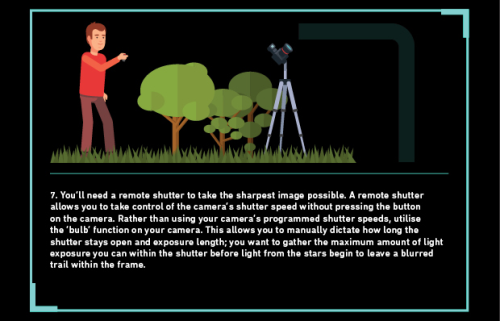
Top tip: use a remote shutter control. (Courtesy: Clifton Cameras)
By Hamish Johnston
If you are lucky enough to live somewhere with dark skies, you know that the Milky Way is a truly majestic sight. But how exactly would you go about capturing its magnificence with a camera? UK-based Clifton Cameras has put together an infographic with a few helpful hints. The image above is an excerpt and you can view the entire infographic here.
View all posts by this author | View this author's profile
Send a birthday card to Fermilab, a huge periodic table, art meets quantum computing
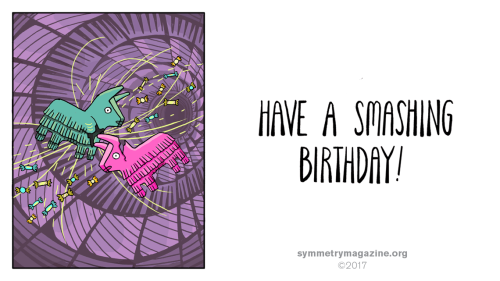
Best wishes: a birthday card for Fermilab (Courtesy: Corinne Mucha/ Symmetry)
By Hamish Johnston and Sarah Tesh
50 years ago this month, the particle physics facility that was to become Fermilab opened its doors for the first time. To celebrate a half a century of physics on the Illinois prairie, the folks at Symmetry have produced a set of themed birthday cards that you can print-out and send to your friends and family. Indeed, there is still time to send a card to Fermilab itself, because the big day isn’t until next Thursday (15th of June). My favourite card (above) uses colliding piñatas to illustrate the plethora of particles that were produced in Fermilab’s Tevatron – which smashed together protons and antiprotons between 1983-2011.
View all posts by this author | View this author's profile
Sculpture inspired by neutrino lab unveiled

Putting it all together. (Courtesy: Garrett Elliott)
By Michael Banks
A sculpture inspired by the geometry of the neutrino detector at the Sudbury Neutrino Observatory (SNO) has been unveiled at Queen’s University in Kingston, Canada.
SNO, which operated from 1999 to 2006, was located 2.1 km underground in Sudbury, Ontario, and designed to detect neutrinos from the Sun through their interactions with a large tank of heavy water.
View all posts by this author | View this author's profile
